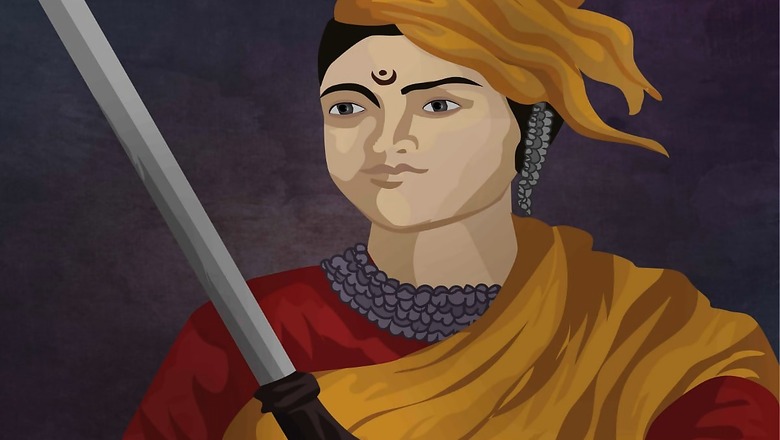
views
It is time to remember a beautiful 23-year-old woman who was pure in conduct and had powerful organisational and combat skills that few possessed. Filled with patriotism and pride for her country, it was Bharat’s fortune to have her as a daughter and a queen.
Maharani Lakshmi Bai, the fearless queen of Jhansi, was one of the leading figures of the 1857 War of Independence. Rani Lakshmi Bai’s spirited fight against the enemy of her country left an indelible mark on Indian history. She is an inspiration for the women of Bharat. Nearly 163 years after the First War of Independence, fearless Indian women feel proud when called ‘Jhansi ki Rani’.
In Varanasi, on November 19, 1835, Moropant Tambe and his wife Bhagirathi Bai were blessed with a daughter who would be a blazing sword in the hands of Bharat Mata. She was named Manikarnika; Manu was her nickname. Her mother died when she was four years old. Her father worked for Peshwa Baji Rao II of Bithoor district. The Peshwa called her “Chabili” because of her spirited demeanour. It was in the company of Prince Nana Sahib and Tatya Tope that she was trained in shooting, horsemanship, fencing and mallakhamba besides reading and writing. These were the lessons she was destined to use to defend Bharat. She was more independent than other children her age.
The Queen of Jhansi
In 1842, “Chabili” was married to Maharaj Gangadhar Rao Baba Sahib of Jhansi, and became the queen of Jhansi, popularly known as Rani Lakshmi Bai of Jhansi. She was extremely popular at the Court of Jhansi and gained the affection and loyalty of her subjects. After the death of the maharaja, the British refused to acknowledge Damodar Rao (adopted son) as the legal heir to the throne of Jhansi, citing the Doctrine of Lapse, a policy introduced by then Governor General Lord Dalhousie to capture Indian princely states.
Explaining Lord Dalhousie’s designs of expansion in his book ‘The Indian War of Independence 1857’, Vinayak Damodar Savarkar writes, “The land-hunger of Dalhousie was not satisfied even after swallowing not only Punjab but also the extensive dominion of Burma. Though the frontiers of India were extended, there remained the graves of ancient kingdoms within. Dalhousie therefore began to root these out and level everything. Not only did they occupy too much valuable space, but there was the fear that from these graves might one day rise the future avengers of India’s wrongs.”
Doctrine of Lapse was just one the many oppressive measures that East India Company was using against Indians. Bharat was facing religious persecution, political, human rights violations, and exploitation of its natural resources. Its centuries-old established institutions were facing extinction.
The great uprising that started against the company rule and its ways reached Jhansi in June 1857. Jhansi under the able rule of Queen Lakshmi Bai soon became a stronghold of revolutionaries of Independence struggle. This irked British who were eyeing to usurp Jhansi. Sir Hugh Rose was given the charge to attack Jhansi, but the English army suffered enormously as soon as they set foot on the soil of Jhansi. All tracts of land surrounding Jhansi had been laid waste at the orders of the queen to restrict supplies to the enemy. Not a blade of corn in the fields, not a vestige of grass on the meadows, not even a tree which could afford them shelter. But the English managed to approach Jhansi.
The Revolutionary
Rani Lakshmi Bai decided to join the revolutionary forces and began training an army in the state of Gwalior. Her active engagement and strategic prowess inspired everyone. The people of Jhansi were praying for the success of the country. Its temples blessed the soldiers who went to the battlefield and tended to the wounded who returned.
The British troops, close on her heels, attacked Gwalior on a scorching summer morning in June 1858. She led a counter-charge, “clad in the attire of a man and mounted on horseback,” British historians John Kaye and George Malleson wrote in ‘History of the Indian Mutiny of 1857-58’ (1890).
Describing her last battle, the English writers say, “Immediately the beautiful Ranee went over the field and made a firm stand against the array of Sir Hugh Rose. She led her troops to repeated and fierce attacks and, though her ranks were pierced through and were gradually becoming thinner and thinner, the Ranee was seen in the foremost rank, rallying her shattered troops and performing prodigies of valour.”
The final battle was fought in June, 1858. The Rani, who had been riding a horse, was struck by bullets and fell. As soon as she was dead, in accordance with her last wish, she was placed on a pile of dry grass and cremated, unseen by the enemy and untouched by the shackles of slavery.
Describing the Queen of Jhansi, Sir Hugh Rose (officer commanding the force that took Jhansi and Gwalior) said, “The Ranee (queen) was remarkable for her bravery, cleverness and perseverance; her generosity to her subordinates was unbounded. These qualities, combined with her rank, rendered her the most dangerous of the rebel leaders … the Indian Mutiny had produced but one man, and that man was a woman.”
Twenty years after her death Colonel Malleson wrote in the ‘History of the Indian Mutiny (vol. 3)’, “Whatever her faults in British eyes may have been, her countrymen will ever remember that she … lived and died for her country. We cannot forget her contribution for India.”
The revolutionary war of 1857 saw one of the strongest all-pervasive resistance to British colonialism. It showed how a common goal of liberation of the motherland can connect people of different class, creed and religion and bring them together to lead a national struggle. As we are going to celebrate the 75th year of India’s Independence, this spirit must be rekindled and revered. That would be true homage to the sacrifices made by Rani Lakshmi Bai.

















Comments
0 comment